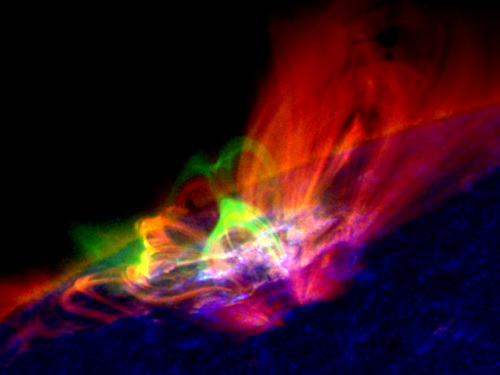Imaging coronal magnetic-field reconnection in a solar flare
2013-08-03July 14, 2013, Dr. Su Yang and his colleagues reported on their latest results in Nature Physics. By combining the Solar Dynamics Observatory (SDO) and Reuven Ramaty High Energy Solar Spectroscopic Imager (RHESSI) data, they studied the events of August 17, 2011, a C-class flares, and first revealed the details of magnetic reconnection process when the solar flare occurs.

By with GAN Weiqun
Scientists want to better understand the magnetic reconnection process, which led to violent eruptions on the sun - such as solar flares and coronal mass ejections (CME). These violent explosions would release large amounts of radiation and high-energy particles, which can affect satellites near Earth and interfere with radio communications. One reason why it’s so hard to study is that magnetic reconnection can’t be witnessed directly, because magnetic fields are invisible. Instead, scientists use a combination of computer modeling and a scant sampling of observations around magnetic reconnection events to attempt to understand what’s going on.
Now, scientists have found a new observational evidence. Su and his colleagues searched SDO observations and found the direct images of magnetic reconnection on the sun. Although the magnetic field lines are not visible, they can make the charged particles moving along the magnetic field lines. Space telescope can see that bright lines looping and arcing through the sun's atmosphere, and so map out the presence of magnetic field lines. Looking at a series of images, Su saw two bundles of magnetic field lines move toward each other, meet briefly to form what appeared to be an "X"-shaped configurations, and then shoot apart with one set of lines and its attendant particles leaping into space and one set falling back down onto the sun. The scientists also confirmed this event is indeed a case of magnetic reconnection by using RHESSI data.
Dr. Su was graduated from Purple Mountain Observatory in 2011 , now he is engaged in postdoctoral at the University of Graz, Austria. Purple Mountain Observatory, as the article's cooperative units, their work was supported by the National Basic Research Program of China (973 Program) and Natural Science Foundation.
The work by SU Yang et al., has been accepted to be published in Nature Physics, 2013, ( http://www.nature.com/nphys/journal/vaop/ncurrent/full/nphys2675.html)

 Search
Search

